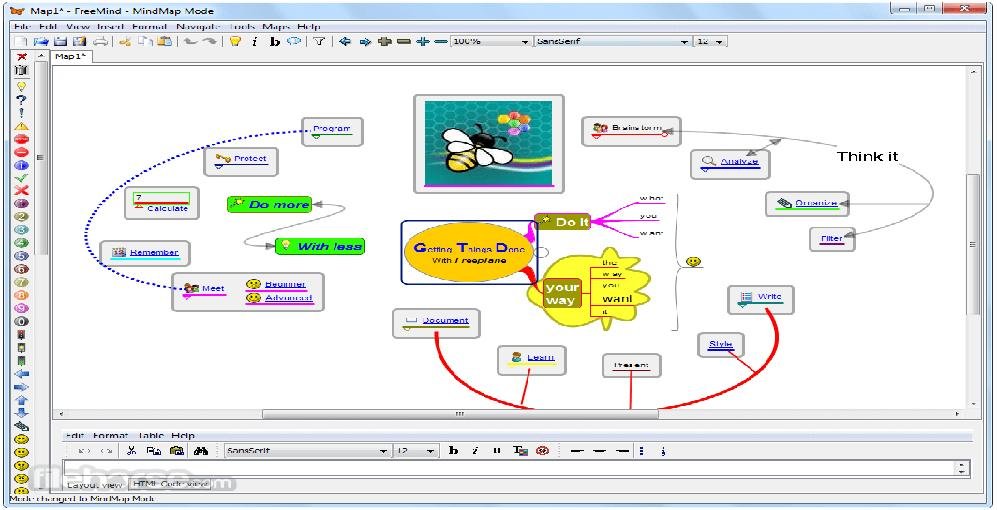Mind Mapping, How To Use it to Enhance Your Life
Mind Mapping is one tool to use for organizing efficiently every part of your life. Still, there are many tools you can use for the same purpose these days. Technology being what it is, you can pick up a smartphone or tablet and download an application geared towards whatever you’re trying to accomplish. That’s the beauty of advancing technology; you’ll always find something that can accomplish whatever it is you want to do. Still, with advancing technology, there are products or tools that offer better features and can accomplish what you want more effectively. Mind Mapping is one of those tools.
With the space between your two ears, or your brain, there aren’t many tools that can jettison the thoughts and idea in your head or organize them for better utilization better than a mind-map.
What is a Mind Map?
A mind map is an image that represents words, tasks, and concepts link to an idea. It is a way to harness the power of your mind by tapping the part of your brain that analyzes information quickly and efficiently. When you use words and images to represent a concept or an idea, you are facilitating your ability to solve problems, think critically, and make decisive decisions. Think of mind mapping as a visual structure that enables you to organize your thoughts and ideas.
The Theory behind Mind Mapping
Using visual aids to represent thoughts exists for centuries from different cultures. Consider the hieroglyphics of ancient Egypt, pictograms used by the Aztecs. The origins of using images to represent thoughts go back in time. However, Tony Buzan, a British Psychologist and businessman, used the visual structure of hieroglyphics and pictograms to reimagine today’s concept of mind mapping.
The Components of a Mind Map
You create a mind map by using a central thought, and branches to expand on that thought to elaborate on ideas or issues. Visualize a tree and the trunk of the tree being the central thought and its branches representing the expansion of that original thought. A mind map can be as simple as an initial thought and its expansion, or it can be as intricate or elaborate as incorporating images and texts to branches, sub-branches, and twigs, which represents lesser thoughts relevant to a final concept.
Benefits & Uses of Mind Mapping
Mind mapping harnesses the power of your mind by using the left and right side of your brain. It takes advantage of the brain’s ability to be imaginative, analytical and logical; and allows the use of the brain’s power to store and remember relevant information. Your brain also elaborates on the specifics of information or ideas. Mind mapping can help to develop the ability to improve the understanding of information. It also increases the ability to generate new concepts, organize and structure thoughts for better utilization.
Related: Productivity Tools To Use For Convenience
Mind maps have many uses for both individuals and businesses alike. Whether a stay-at-home parent in the suburbs planning a party or organizing ideas. Possibly a student studying and memorizing course work. Maybe a CEO of a Fortune 500 company; analyzing critical information or outlining the specifics of a meeting. Mind mapping can help to facilitate clearer thinking, self-organization, and utilization.
How to Mind Map
We can find one of the best link on the internet about mind mapping on paper on Lifehack.com. In this brief post, you can learn the basics of mind mapping using paper and colorful markers. The basic tools for releasing the flow of ideas. Grasp the basics of mind mapping to realize there is no wrong or right way to mind-map. It’s actually based on individual goals to accomplish using this useful tool. The key points to remember is all mind mapping begins with a concept or idea, which leads to branches or sub-branches revolving around that concept or idea.
As a preference, I would rather mind map with software. Using paper and pen can be helpful in beginning with the flow of ideas. Still, I love the neatness and organization of using software. I also believe that ideas transition from the mind more freely. Of course, this is a preference, as there are those who believe mind mapping on paper is a much more efficient way of releasing ideas and thoughts.
Mind Mapping Software
Search online and you discover that there are many mind mapping softwares available. As a longtime user, I would like to share my top four preferences. Like the decision to mind map manually or not, your software preference is also a personal one. The four listed below do not represent the best of what’s available. I chose them based on my personal experience.
XMind
Xmind Offers a free version and a paid version with a reasonable cost of $60 annually.
This app supports all platforms. Ideas grows on trees is their slogan and a great representation of what mind mapping is. It offers the typical set of features you will find with most applications.
Different layout options or templates.
Cloud syncing
keyboard shortcut
Chart creations
What stands out with Xmind is its interface. It is a solid software that’s filled with features to achieve productivity while mapping thoughts and ideas. Before making the leap financially to the paid version, try the free version first. If you enjoy using the free version, then upgrading to the paid version would be beneficial.
What is interesting about the different mind-mapping applications are their interface. The interface of Xmind is easy to use and may even be unique. I love their hand-drawn style. It also uses vivid eye-catching colors which Xmind call smart color.
Freemind
Freemind is open source, which means you can use it for free.
An open source mapping software that is also filled with feature rich options, some of which integrate well with Microsoft Office or other business applications. If you can’t afford the expense of a commercial brand mind-mapping application, this one would be ideal. It’s also perfect for first-time users wanting to learn more about mind mapping.
If you are using two different operating systems, Freemind is ideal because it is compatible with Windows, OS X, and Linux. As an open source software, you can expect continuous improvements to benefit the end users.
MindManager
MindManager offers a free 30-day trial and a starting annual cost of $99. This Application also supports Windows and Mac.
Design for businesses other than individuals, it’s considered an industry standard for companies wanting to boost productivity as well as enhance creative thinking. Like Xmind, It has Gantt charting capabilities, and its ability to break projects into manageable segments makes it ideal for medium to large companies and individuals alike, looking to enhance productivity. As overwhelming as MindManager may seem to individuals, don’t exclude it as an option. MindManager’s features can benefit non-business users, especially if you are an uber organizer wanting to manage personal processes and projects.
MindNode
MindNode is a macOS and iOS platform only. There isn’t a trial version, but it is available for either $2.49 per month or 19.99 annually.
After using the above softwares, I choose MindNode for a variety of reasons. First, I’m a minimalist. I love clean lines and simple features. When I first used mind-mapping, I was also using a PC, and I’ve since changed my computing hardware and now use a MAC, iPad and iPhone. Yes, MindNode is IOS based, so you will not find this application for use with Windows.
While there are many applications that function in both environments, I choose to stick with MindNode because its interface suits me, and its ability to function effectively on my MAC, iPad and iPhone. MindNode offers many of the features of the other applications I’ve shared, but again, aesthetics were important for me.
To Conclude
MindNode is my choice, however, I am not promoting any of the software above. Nor am I saying these are the only options. Check online and you can easily discover that your options are extensive when choosing which mind-mapping application to use.
Whether you choose pen and paper, or one of the many applications available, I think what’s important is to start mind mapping. Discover the benefits of visual thinking, its power to transform the way you think and retain information and rationalize ideas. It will unlock the power of the brain by sharpening the mind while helping to bring ideas to reality.
Its ability to transform your thoughts; to take an idea and expand it to the point of reality, a technique that can help with organization and efficiency.













